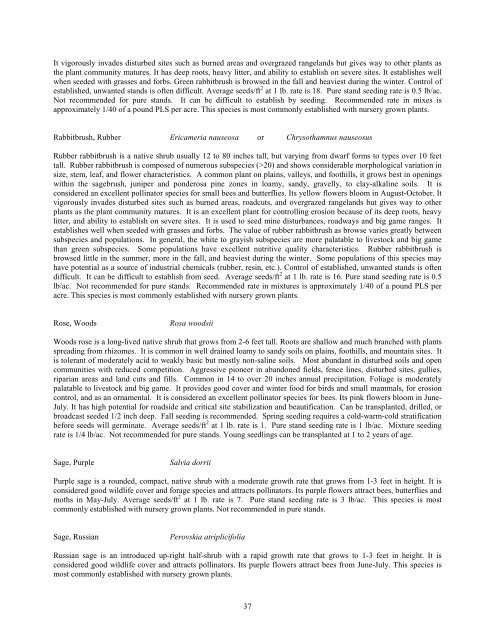Idaho Plant Materials Technical Note No. 24
Idaho Plant Materials Technical Note No. 24
Idaho Plant Materials Technical Note No. 24
You also want an ePaper? Increase the reach of your titles
YUMPU automatically turns print PDFs into web optimized ePapers that Google loves.
It vigorously invades disturbed sites such as burned areas and overgrazed rangelands but gives way to other plants as<br />
the plant community matures. It has deep roots, heavy litter, and ability to establish on severe sites. It establishes well<br />
when seeded with grasses and forbs. Green rabbitbrush is browsed in the fall and heaviest during the winter. Control of<br />
established, unwanted stands is often difficult. Average seeds/ft 2 at 1 lb. rate is 18. Pure stand seeding rate is 0.5 lb/ac.<br />
<strong>No</strong>t recommended for pure stands. It can be difficult to establish by seeding. Recommended rate in mixes is<br />
approximately 1/40 of a pound PLS per acre. This species is most commonly established with nursery grown plants.<br />
Rabbitbrush, Rubber Ericameria nauseosa or Chrysothamnus nauseosus<br />
Rubber rabbitbrush is a native shrub usually 12 to 80 inches tall, but varying from dwarf forms to types over 10 feet<br />
tall. Rubber rabbitbrush is composed of numerous subspecies (>20) and shows considerable morphological variation in<br />
size, stem, leaf, and flower characteristics. A common plant on plains, valleys, and foothills, it grows best in openings<br />
within the sagebrush, juniper and ponderosa pine zones in loamy, sandy, gravelly, to clay-alkaline soils. It is<br />
considered an excellent pollinator species for small bees and butterflies. Its yellow flowers bloom in August-October. It<br />
vigorously invades disturbed sites such as burned areas, roadcuts, and overgrazed rangelands but gives way to other<br />
plants as the plant community matures. It is an excellent plant for controlling erosion because of its deep roots, heavy<br />
litter, and ability to establish on severe sites. It is used to seed mine disturbances, roadways and big game ranges. It<br />
establishes well when seeded with grasses and forbs. The value of rubber rabbitbrush as browse varies greatly between<br />
subspecies and populations. In general, the white to grayish subspecies are more palatable to livestock and big game<br />
than green subspecies. Some populations have excellent nutritive quality characteristics. Rubber rabbitbrush is<br />
browsed little in the summer, more in the fall, and heaviest during the winter. Some populations of this species may<br />
have potential as a source of industrial chemicals (rubber, resin, etc.). Control of established, unwanted stands is often<br />
difficult. It can be difficult to establish from seed. Average seeds/ft 2 at 1 lb. rate is 16. Pure stand seeding rate is 0.5<br />
lb/ac. <strong>No</strong>t recommended for pure stands. Recommended rate in mixtures is approximately 1/40 of a pound PLS per<br />
acre. This species is most commonly established with nursery grown plants.<br />
Rose, Woods<br />
Rosa woodsii<br />
Woods rose is a long-lived native shrub that grows from 2-6 feet tall. Roots are shallow and much branched with plants<br />
spreading from rhizomes. It is common in well drained loamy to sandy soils on plains, foothills, and mountain sites. It<br />
is tolerant of moderately acid to weakly basic but mostly non-saline soils. Most abundant in disturbed soils and open<br />
communities with reduced competition. Aggressive pioneer in abandoned fields, fence lines, disturbed sites, gullies,<br />
riparian areas and land cuts and fills. Common in 14 to over 20 inches annual precipitation. Foliage is moderately<br />
palatable to livestock and big game. It provides good cover and winter food for birds and small mammals, for erosion<br />
control, and as an ornamental. It is considered an excellent pollinator species for bees. Its pink flowers bloom in June-<br />
July. It has high potential for roadside and critical site stabilization and beautification. Can be transplanted, drilled, or<br />
broadcast seeded 1/2 inch deep. Fall seeding is recommended. Spring seeding requires a cold-warm-cold stratification<br />
before seeds will germinate. Average seeds/ft 2 at 1 lb. rate is 1. Pure stand seeding rate is 1 lb/ac. Mixture seeding<br />
rate is 1/4 lb/ac. <strong>No</strong>t recommended for pure stands. Young seedlings can be transplanted at 1 to 2 years of age.<br />
Sage, Purple<br />
Salvia dorrii<br />
Purple sage is a rounded, compact, native shrub with a moderate growth rate that grows from 1-3 feet in height. It is<br />
considered good wildlife cover and forage species and attracts pollinators. Its purple flowers attract bees, butterflies and<br />
moths in May-July. Average seeds/ft 2 at 1 lb. rate is 7. Pure stand seeding rate is 3 lb/ac. This species is most<br />
commonly established with nursery grown plants. <strong>No</strong>t recommended in pure stands.<br />
Sage, Russian<br />
Perovskia atriplicifolia<br />
Russian sage is an introduced up-right half-shrub with a rapid growth rate that grows to 1-3 feet in height. It is<br />
considered good wildlife cover and attracts pollinators. Its purple flowers attract bees from June-July. This species is<br />
most commonly established with nursery grown plants.<br />
37
















